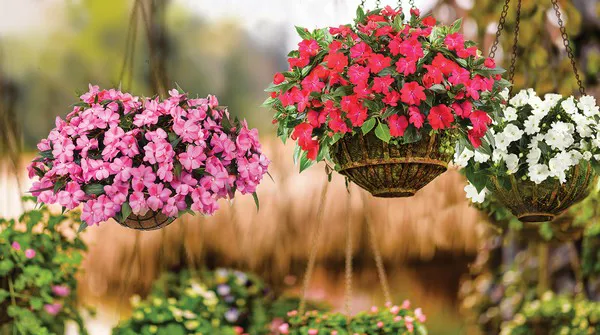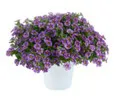Danziger, a floriculture company that has been bringing offerings to market since its inception in 1953, knows a bit about ornamental alchemy. The process begins with a dedication to breeding for the right genetics.
“Danziger’s approach to innovation is in the breeding, and we do things by necessity,” says Mike Fernandez, Market Manager North America for Danziger. “Normally, Danziger will decide on a model and breed towards that model, with certain parent plants providing the necessary traits. Once the breeders get the model plant, then it’s pretty easy to replicate it with others using embryo rescue and other current techniques.”

The company’s newest collections are the result of an initiative that began decades before. In collaboration with its breeders in Israel, Danziger sought to develop controlled-growth plants. Such plants would help to minimize and eliminate the use of plant growth regulators (PGRs).
“PGR usage is a bigger issue in Europe, but eventually, it’ll be here, too,” Fernandez says. “Growers are producing so many items now. The easier you can make things for the grower, the better. Taking out that PGR need, of course, does this for them.”
 Vanessa Verbena
Vanessa Verbena
When Danziger first began its controlled-growth initiative, the breeders began with verbena. They also looked at two other problems this genus frequently battles: powdery mildew and cycling out of color/not reblooming. The team went to work on developing a verbena that performed better. Danziger’s Vanessa series does it all.
“Vanessa had to be able to stay in color all summer long in our trials or it’s not in the series,” Fernandez says. “Otherwise, it’s not good for the consumer, and the grower doesn’t want something that goes out of color before it hits the shelves. For the mildew problem, we also set a very high bar. If we see mildew in any trials anywhere in the world, we pull the variety out of the series. That alone will take care of a lot of problems.”
 Capella Petunia
Capella Petunia
While a lot of companies have introduced early petunias into the market, many of the offerings sacrifice their performance in order to be first. This means many petunias look lackluster in the greenhouse and quit long before the summer ends. Capella sought to remedy these petunia problems.
“With Capella, you get both you get a good compact plant and the flowers start early enough to be in those small pots,” Fernandez says. “Then later, we’ll get some good size in the garden. The series will perform through the entire summer.”
 Mega Pazzaz Portulaca
Mega Pazzaz Portulaca
Danziger has produced a few Pazzaz offerings. Each one improves on the last. There was regular Pazzaz, a portulaca, followed by the compact variety Pazzaz Nano, which expanded the flowers from the edges of the plant into the middle. Mega Pazzaz, Fernandez says, is a bigger Nano.
“It’s a big ball of color, and it gets flowers over the middle and all over the plant,” he says. “The flowers are big. Of course, they do close at night like other portulaca, but I can say that Mega Pizzazz stays open more reliably and does start earlier than our other varieties. I think we’ve come a long way with portulaca.”
 Harmony Colorfall New Guinea Impatiens
Harmony Colorfall New Guinea Impatiens
This series has been an exercise in patience. Although Danziger has been breeding the Harmony series for years and first brought the product to the North American market, trailing New Guinea impatiens posed a unique challenge. Success required a lot of trial and error.
“There have been at least 10 attempts at trailing New Guineas, but they’ve never actually been trailing where they come around the basket with a nice controllable shape that’s not too big,” Fernandez says. “That’s what Colorfall is. It’s made for baskets.”
 Nesia Nemesia
Nesia Nemesia
For those interested in a nemesia that can handle the heat, look no further than the Nesia series. The line of plants was bred in Israel, and Costa Farms reported that it maintained its color throughout the summer in Miami.
“That exceptional heat tolerance kind of changes the market for a nemesia because now you can grow one that you’ll be able to sell for longer, and the consumers know it’s going to stay nice,” Fernandez says.
 Colibri Calibrachoa
Colibri Calibrachoa
Danziger’s compact calibrachoa series, Colibri, now has three new colors: Purple Bling and Pink Bling with a vibrant striped pattern, and Abstract Guava with a cheery watermelon-like pattern. While the color introductions are exciting, Colibri is for its compact size. Instead of stopping its growth when it reaches peak size, Colibri will continue to flourish long after consumers bring it home.
“The best thing is that this series is easy, as the PGR use is minimal or none,” Fernandez says. “These calibrachoas are pH tested. They’re not sensitive to heat, and they’re compact, which makes them good for quarts up to tidy baskets. They’ll also flower in a ten-hour day, so they don’t need additional lighting or manipulation.”
All of Danziger’s series have top-quality breeding and genetics. Fernandez says that this is the easy part. What truly sets Danziger apart in the marketplace is the company’s ability to be a reliable industry partner and go above and beyond expectations.
“Ultimately, a lot of people can bring plants with good grading to the market, but we bring the full value chain,” Fernandez says. “From the outstanding service and last-minute orders to the reliable production and superior genetics, it’s all aimed at the customer. That’s Danziger.

For more information:
Danziger
www.danzigeronline.com
